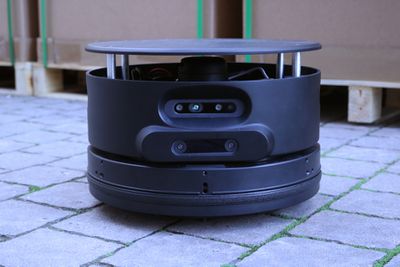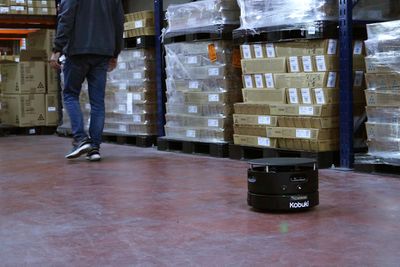Category:Pengo
Contents
Pengo Internal documentation
- Pengo (internal) documentation can be found here (Password protected)
- Pengo
- This effort is now deprecated. New systems are all open sourced.
Hardware
- PC Connection: USB or via RX/TX pins on the parallel port
- Motor Overload Detection: disables power on detecting high current (>3A)
- Odometry: 52 ticks/enc rev, 2578.33 ticks/wheel rev, 11.7 ticks/mm
- Gyro: factory calibrated, 1 axis (110 deg/s)Bumpers: left, center, right
- Cliff sensors: left, center, right
- Wheel drop sensor: left, right
- Power connectors: 5V/1A, 12V/1.5A, 12V/5A
- Expansion pins: 3.3V/1A, 5V/1A, 4 x analog in, 4 x digital in, 4 x digital out
- Audio : several programmable beep sequences
- Programmable LED: 2 x two-coloured LED
- State LED: 1 x two coloured - LED [Green - high, Orange - low, Green & Blinking - charging]
- Buttons: 3 x touch buttons
- Battery: Lithium-Ion, 14.8V, 4400 mAh (4S2P - large) can be doubled
- Firmware upgradeable: via usb
- Sensor Data Rate: 50Hz
- Recharging Adapter: Input: 100-240V AC, 50/60Hz, 1.5A max; Output: 19V DC, 3.16A
- Netbook recharging connector (only enabled when robot is recharging): 19V/2.1A DC
- Docking IR Receiver: left, centre, right
Pengo Wearhouse Robot
- Up to 4 X 3D cameras D435 or D415
- Optional T265 for localization in large areas
- 2D Lidar
- Bumper sensor
- Battery monitoring
- Charging base unit
Pengo Educational Robot
Pengo includes
- 3D camera
- 2D Lidar
- Speakers
- Lilt unit
- Bumper sensor
- Battery monitoring
- Charging base unit
- 2 Linux servers pre-configured with ROS
- Screen with animation for HMI, ROS controlled
Pengo User/Password
<syntaxhighlight lang="bash" line='line'> User: pengo Password : pengo </syntaxhighlight>
Pengo remote login
<syntaxhighlight lang="bash" line='line'> ssh pengo@pengo_ip </syntaxhighlight>
Pengo network Configuration
Pengo IP configuration
Configure static ip:
<syntaxhighlight lang="bash" line='line'>
sudo nano /etc/network/interfaces
</syntaxhighlight>
Now, paste this under # The primary network interface: <syntaxhighlight lang="bash" line='line'> auto lo iface lo inet loopback iface ens33 inet static
address xxx.xxx.xxx.xxx(enter your ip here)
netmask xxx.xxx.xxx.xxx(usually, 255.255.255.0)
gateway xxx.xxx.xxx.xxx(enter gateway ip here,usually the address of the router)
dns-nameservers 8.8.8.8
</syntaxhighlight>
Restrat networking:
<syntaxhighlight lang="bash" line='line'>
systemctl restart ifup@eth0
</syntaxhighlight>
At this point you can check if the settings are correct:
<syntaxhighlight lang="bash" line='line'>
ifconfig
</syntaxhighlight>
ROS IP configuration
Run the following commands in the terminal: <syntaxhighlight lang="bash" line='line'>
cd ~
pico pengo.config
</syntaxhighlight> Edit the parameters under 'User Settings' to have the same IP as from stage 3:
* PENGO_IP= YOUR_STATIC_IP * PENGO_ROS_MASTER = YOUR_STATIC_IP
Reboot the computer and you're ready.
ROS launch configuration
Navigate to: <syntaxhighlight lang="bash" line='line'>
cd ~
</syntaxhighlight> Run the launch file: Note, there is a 15 seconds delay to assure that all of the configurations are done. <syntaxhighlight lang="bash" line='line'>
. pengo-startup
</syntaxhighlight>
Pengo ROS topics
| Topic | Description |
|---|---|
| /odom | Wheels controller. |
| /scan | Scanning an area. |
| /move_base/goal | Move to a certain target. |
| /mobile_base/sensors/imu_data | Data coming from the IMU sensor.Compass, Accelerometer |
| /agentN/ackermann_cmd | Velocity command |
| /amcl_pose | Absolute position published by AMCL node (localization) |
| /agentN/imu | Compass, Accelerometer |
| /map | A map used for localization |
Mapping and localization with Pengo
To control the Pengo you can use Cogniteam's Android app.
This category currently contains no pages or media.


